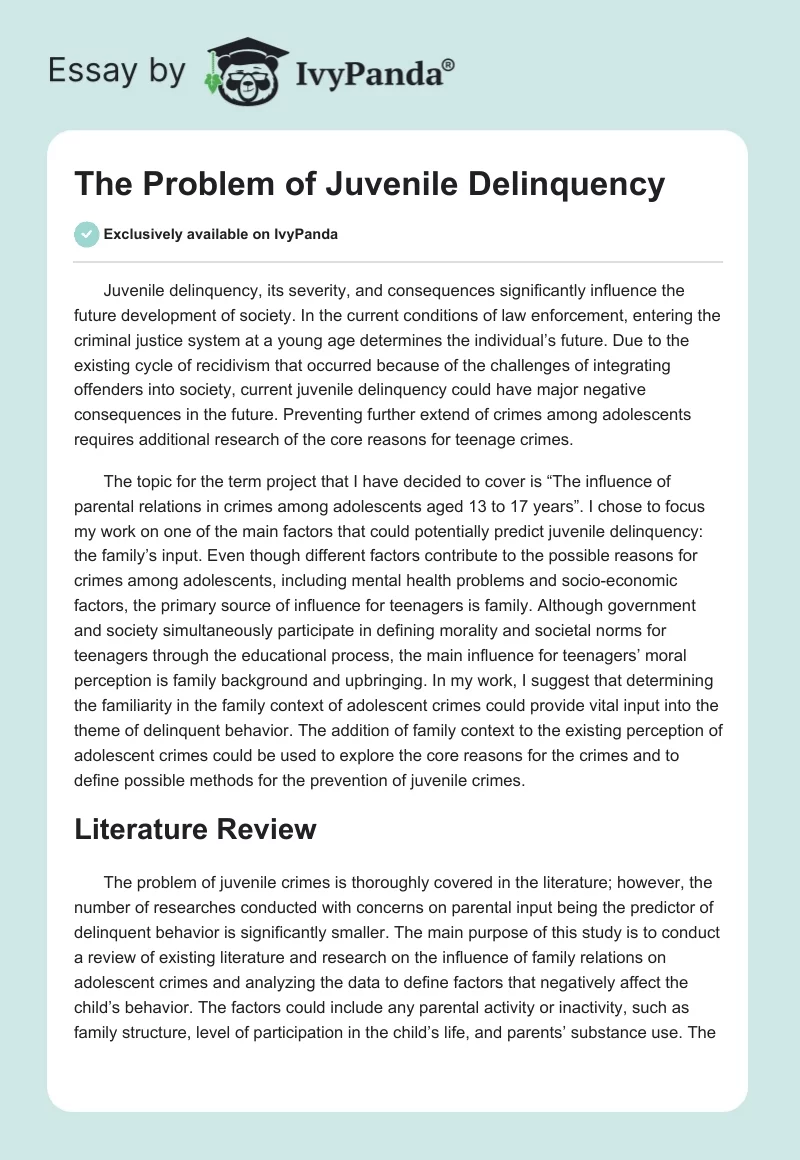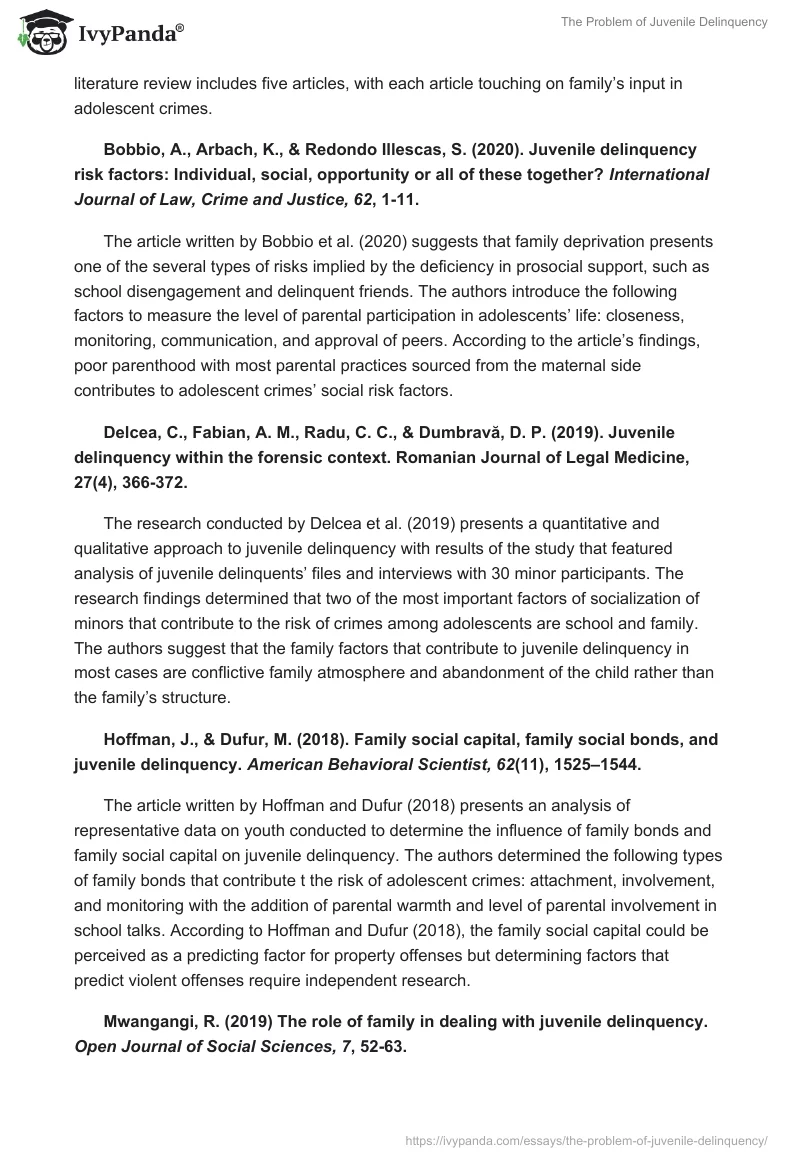Juvenile delinquency, its severity, and consequences significantly influence the future development of society. In the current conditions of law enforcement, entering the criminal justice system at a young age determines the individual’s future. Due to the existing cycle of recidivism that occurred because of the challenges of integrating offenders into society, current juvenile delinquency could have major negative consequences in the future. Preventing further extend of crimes among adolescents requires additional research of the core reasons for teenage crimes.
The topic for the term project that I have decided to cover is “The influence of parental relations in crimes among adolescents aged 13 to 17 years”. I chose to focus my work on one of the main factors that could potentially predict juvenile delinquency: the family’s input. Even though different factors contribute to the possible reasons for crimes among adolescents, including mental health problems and socio-economic factors, the primary source of influence for teenagers is family. Although government and society simultaneously participate in defining morality and societal norms for teenagers through the educational process, the main influence for teenagers’ moral perception is family background and upbringing. In my work, I suggest that determining the familiarity in the family context of adolescent crimes could provide vital input into the theme of delinquent behavior. The addition of family context to the existing perception of adolescent crimes could be used to explore the core reasons for the crimes and to define possible methods for the prevention of juvenile crimes.
Literature Review
The problem of juvenile crimes is thoroughly covered in the literature; however, the number of researches conducted with concerns on parental input being the predictor of delinquent behavior is significantly smaller. The main purpose of this study is to conduct a review of existing literature and research on the influence of family relations on adolescent crimes and analyzing the data to define factors that negatively affect the child’s behavior. The factors could include any parental activity or inactivity, such as family structure, level of participation in the child’s life, and parents’ substance use. The literature review includes five articles, with each article touching on family’s input in adolescent crimes.
Bobbio, A., Arbach, K., & Redondo Illescas, S. (2020). Juvenile delinquency risk factors: Individual, social, opportunity or all of these together? International Journal of Law, Crime and Justice, 62, 1-11.
The article written by Bobbio et al. (2020) suggests that family deprivation presents one of the several types of risks implied by the deficiency in prosocial support, such as school disengagement and delinquent friends. The authors introduce the following factors to measure the level of parental participation in adolescents’ life: closeness, monitoring, communication, and approval of peers. According to the article’s findings, poor parenthood with most parental practices sourced from the maternal side contributes to adolescent crimes’ social risk factors.
Delcea, C., Fabian, A. M., Radu, C. C., & Dumbravă, D. P. (2019). Juvenile delinquency within the forensic context. Romanian Journal of Legal Medicine, 27(4), 366-372.
The research conducted by Delcea et al. (2019) presents a quantitative and qualitative approach to juvenile delinquency with results of the study that featured analysis of juvenile delinquents’ files and interviews with 30 minor participants. The research findings determined that two of the most important factors of socialization of minors that contribute to the risk of crimes among adolescents are school and family. The authors suggest that the family factors that contribute to juvenile delinquency in most cases are conflictive family atmosphere and abandonment of the child rather than the family’s structure.
Hoffman, J., & Dufur, M. (2018). Family social capital, family social bonds, and juvenile delinquency. American Behavioral Scientist, 62(11), 1525–1544.
The article written by Hoffman and Dufur (2018) presents an analysis of representative data on youth conducted to determine the influence of family bonds and family social capital on juvenile delinquency. The authors determined the following types of family bonds that contribute t the risk of adolescent crimes: attachment, involvement, and monitoring with the addition of parental warmth and level of parental involvement in school talks. According to Hoffman and Dufur (2018), the family social capital could be perceived as a predicting factor for property offenses but determining factors that predict violent offenses require independent research.
Mwangangi, R. (2019) The role of family in dealing with juvenile delinquency. Open Journal of Social Sciences, 7, 52-63.
The article written by Mwangangi (2019) covers the author’s study’s results on determining family factors that predict juvenile delinquency. According to Mwangangi (2019), several family-related factors influence child crime rates, including parental attitudes, level of family cohesion, presence of physical violence, and level of parental involvement.
Simmons, C., Steinberg, L., Frick, P. J., & Cauffman, E. (2018). The differential influence of absent and harsh fathers on juvenile delinquency. Journal of Adolescence, 62, 9-17.
The article written by Simmons et al. (2018) provides a substantial input on fathers’ role in the upbringing of juvenile offenders. Father absence is frequently perceived as one of the factors that contribute to juvenile delinquency. However, according to the study results, the strong presence and harsh father-son relations could negatively affect the child’s development and result in the child’s engagement in offending behaviors.
In conclusion, the current state of literature related to the topic lacks a thorough analysis of how each family factor influences juvenile delinquency. The majority of literature focuses on either maternal or parental support of the child and socio-economic factors, without significant concerns on the family structure and the family’s emotional climate. The current work is geared toward filling the gap in the existing body of knowledge by providing a thorough analysis of the family influence on adolescent crimes in family structure, the emotional component, and the level of parental participation from both mother and father.
Methodology
The methodology for this project is constructing a literature review and analyzing the existing body of knowledge in order to define family factors that influence juvenile delinquency. The study is aimed to prove that family issues present one of the primary factors that cause crime commitment among adolescents. Social bonds between the family members influence delinquent behavior (Hoffman & Dufur, 2018). Through the literature review and original analysis of acquired data, the study results will provide information on the possible family factors contributing to juvenile delinquency among adolescents aged thirteen to seventeen. Understanding the relationship between psychological problems coming from childhood relates to the social bond between parent and children, which is essential in exploring the reasons for juvenile delinquency.
References
Bobbio, A., Arbach, K., & Redondo Illescas, S. (2020). Juvenile delinquency risk factors: Individual, social, opportunity or all of these together?International Journal of Law, Crime and Justice, 62, 1-11.
Delcea, C., Fabian, A. M., Radu, C. C., & Dumbravă, D. P. (2019). Juvenile delinquency within the forensic context. Romanian Journal of Legal Medicine, 27(4), 366-372.
Hoffman, J., & Dufur, M. (2018). Family social capital, family social bonds, and juvenile delinquency.American Behavioral Scientist, 62(11), 1525–1544.
Mwangangi, R. (2019) The role of family in dealing with juvenile delinquency. Open Journal of Social Sciences, 7, 52-63.
Simmons, C., Steinberg, L., Frick, P. J., & Cauffman, E. (2018). The differential influence of absent and harsh fathers on juvenile delinquency.Journal of Adolescence, 62, 9-17.


